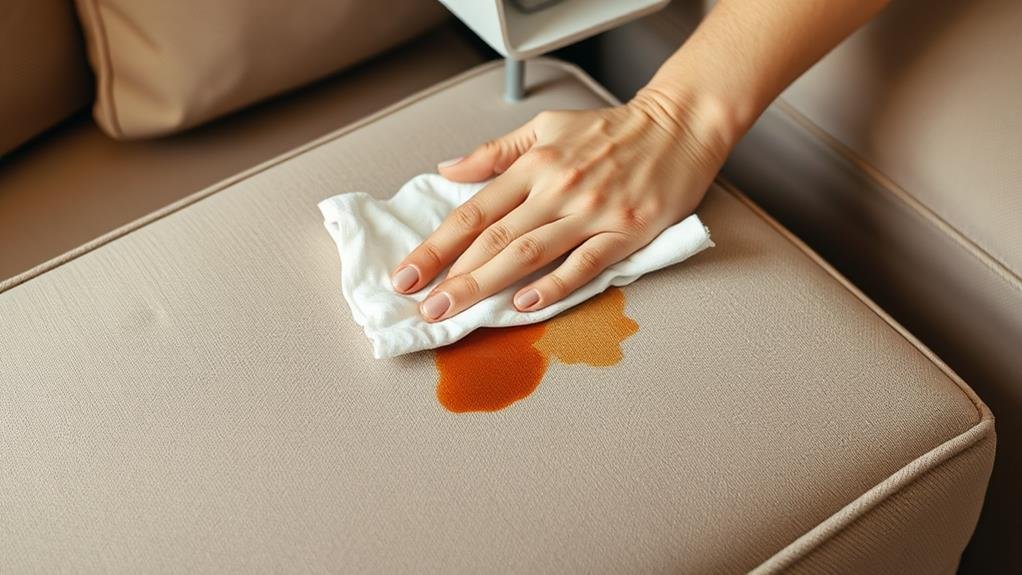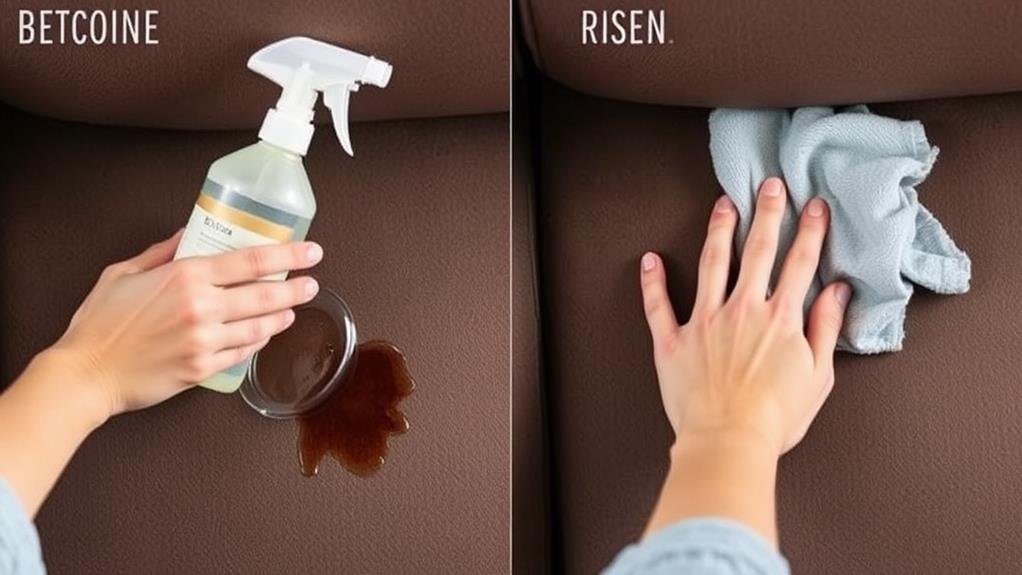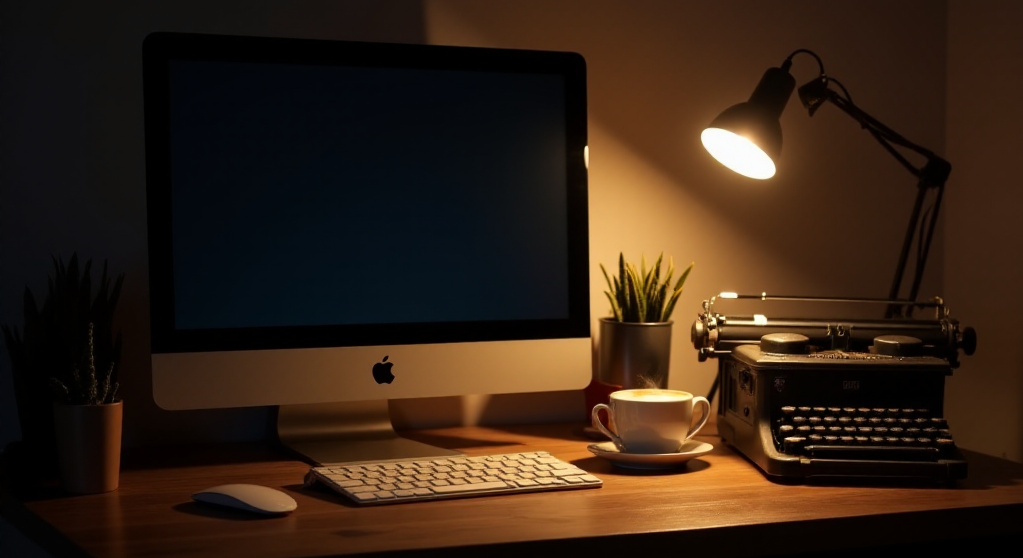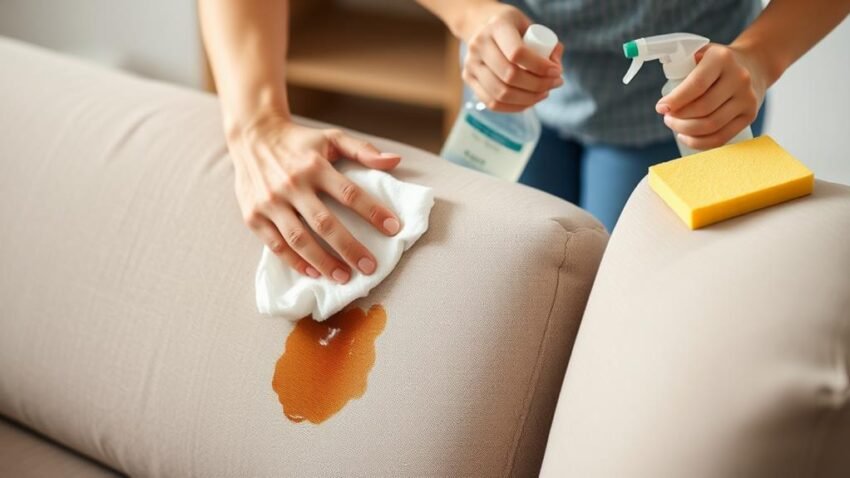I know it can be frightening when coffee spills onto your couch, but there's no need to panic. Acting promptly is key to removing the stain effectively. Start by blotting the spill with a clean cloth or paper towel—don't rub, as that can push the stain deeper into the fabric. Now, you might be wondering what to do next. Prepare a simple cleaning solution and let's take it one step at a time to guarantee your couch looks as good as new again. The right approach can make all the difference. Let's get started
Act Quickly to Blot

When you spill coffee on your couch, act promptly to blot the stain. Quick action is important because hot coffee can soak into the upholstery rapidly, making it harder to remove if it sets. Swiftly responding to the spill can prevent it from becoming a lasting stain. Blotting the coffee stain right away helps prevent it from setting deep into the couch fabric.
Avoid rubbing the stain, as this can spread it further and push the coffee deeper into the fibers. Instead, blot gently with a clean cloth or paper towel to absorb as much of the coffee as possible without spreading it. This method ensures that you remove the liquid without pushing it further into the fabric. Remember to use a dry cloth to absorb excess liquid and consider sprinkling baking soda to absorb any lingering odor, as seen in preventive measures.
Acting promptly is essential to preventing a lasting stain on your couch. The sooner you address the spill, the better your chances of completely removing the stain. By blotting quickly and carefully, you can protect your upholstery and maintain your couch's appearance. Remember, every second counts when dealing with a coffee spill on your couch fabric.
Prepare Cleaning Solution
Preparing a cleaning solution is the next step in removing coffee stains from your couch. To guarantee you have an effective and safe solution, follow these steps:
- Mix equal parts of white vinegar and water for a gentle yet effective cleaning solution. Additionally, you might consider using natural disinfectants like lemon juice, which can help break down tough stains. Cleaning with lemon juice can also eliminate odors and prevent future stains.
- Test the cleaning solution on a hidden area of the couch to check for colorfastness. This will help you avoid any potential damage to the upholstery fabric.
- Avoid using harsh chemicals that can damage the fabric or discolor it.
When preparing the cleaning solution, it's important to be mindful of the materials involved. Here's how you can proceed:
Pour equal parts of white vinegar and water into a bowl or spray bottle. Before applying this solution to the coffee stain, make sure to test it on a hidden area of your couch to confirm it won't change the color of your upholstery fabric. Once you're confident it's safe, gently dab the cleaning solution onto the coffee stain without spreading it further. Allow the solution to sit for a few minutes before blotting it away with a clean cloth.
This method helps lift the stain without causing damage to your couch's fabric.
Apply and Rinse Gently

To eliminate the coffee stain from your couch, gently administer the cleaning solution directly onto the stain. This method aids in preventing the spread of the stain across the upholstery. Utilize a soft cloth or sponge to gently dab and lift the stain from the fabric. Avoid vigorous rubbing, as this action can harm the fabric.
| Step | Action |
|---|---|
| Administer | Utilize a clean cloth or sponge to gently administer the cleaning solution directly on the stain. |
| Dab | Gently dab and lift the stain from the upholstery without rubbing. |
| Rinse | Rinse the area with cold water to eliminate any cleaning solution residues. |
| Dry | Pat the area dry with a clean towel to absorb excess moisture and prevent mold. |
After administering and dabbing the cleaning solution, rinse the area with cold water to ensure all residues are eliminated. This step is essential for effective stain removal and maintaining the health of your couch's upholstery. Finally, pat the area dry with a clean towel to absorb any excess moisture, which helps prevent mold growth.
Alternative Cleaning Methods
If the initial method doesn't work, there are several alternative cleaning methods you can try to eliminate coffee stains from your couch. These methods can be particularly beneficial if you don't have access to commercial cleaners or if the stain is particularly persistent.
- Use Sparkling Water: For fresh coffee stains, try using sparkling water for carbonation to lift the stain.
- Detergent Mixture: Create a blend of warm water and detergent; this is effective for cleaning coffee stains.
- Glass Cleaner for Dried Stains: For dried-on stains, moisten the area and apply clear glass cleaner before blotting dry.
When dealing with a coffee spill on your couch, it's crucial to act quickly. If the stain is severe or you're uncertain about how to proceed, consider seeking professional cleaning services to restore the fabrics properly. However, for many cases, a small amount of baking soda or a mild cleaning solution can help eliminate excess coffee without damaging the upholstery. Always treat the area with cold water to prevent setting the stain further. If there is a remaining stain after your initial attempts, do not hesitate to seek professional cleaning advice to achieve the best results.
Dry and Maintain Upholstery

After successfully removing the coffee stain, it's essential to dry and maintain your upholstery to make sure it remains in good condition. Regularly vacuum your couch to prevent dirt and debris buildup that can lead to future stains. This simple practice helps keep your couch clean and prevents the accumulation of particles that could cause more stains over time.
To guarantee thorough maintenance, use a soft brush attachment on your vacuum cleaner. This gently removes dust and dirt from the upholstery without damaging it. Additionally, rotate and fluff cushions regularly to prevent uneven wear and tear on your couch. This keeps your couch looking newer for longer and prevents certain areas from becoming overly worn.
Avoid direct sunlight exposure as it can cause fading and discoloration of the upholstery fabric. If you notice your couch needing a deeper clean after removing coffee stains, consider professional upholstery cleaning services. They can provide the necessary care to keep your couch in best condition.
Conclusion
Removing a coffee stain from your couch is a task that requires swift action and the right techniques. By blotting the stain immediately, using a vinegar solution, and gently rinsing, you can prevent permanent damage. If needed, try alternative methods like sparkling water or detergent mixtures. Remember to dry the area thoroughly to avoid mold growth. Regular maintenance through vacuuming and rotating cushions will keep your upholstery in pristine condition, much like a well-kept medieval tapestry. Act now to save your couch

